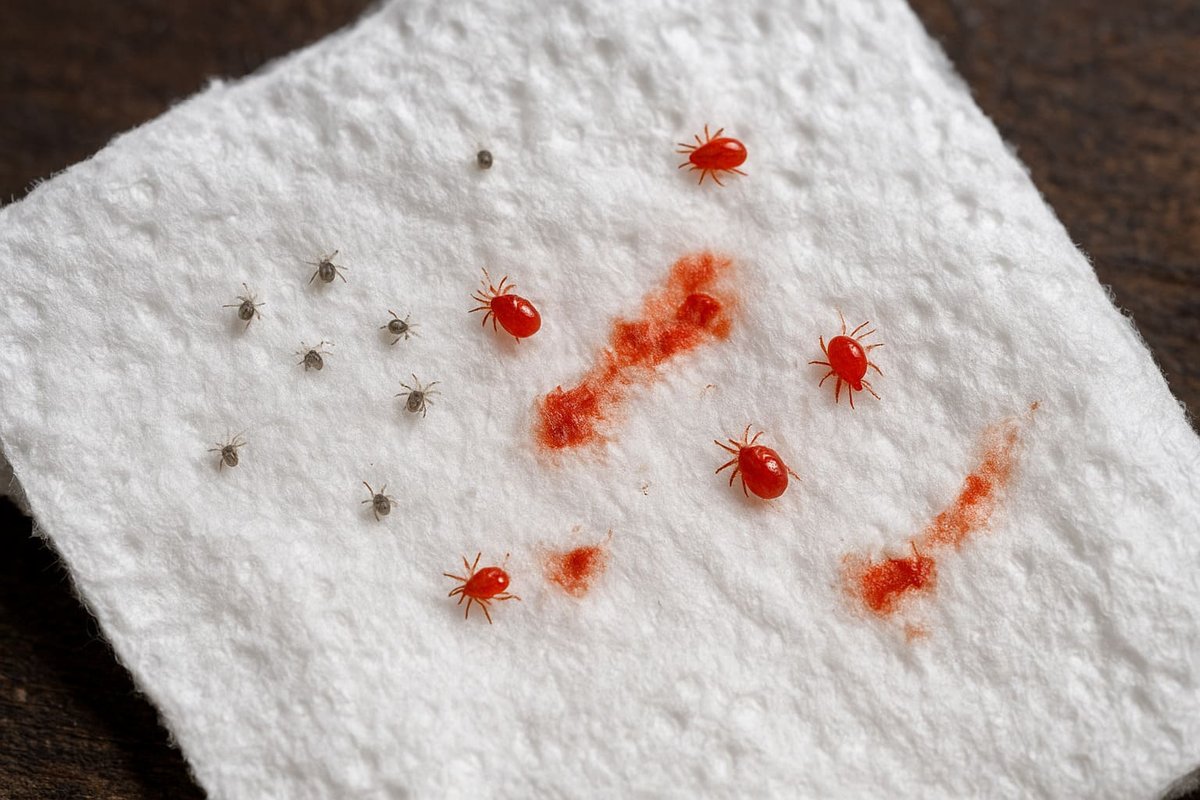(Disclaimer: I am a chicken keeper, not a vet. This guide is for informational purposes and is based on my own experience and research from UK poultry sources. Always consult a poultry vet for health diagnoses, especially before using prescription treatments like Exzolt.)
Red mites. If you’re a UK backyard chicken keeper, just hearing those two words is probably enough to make you itch. These pesky bugs, scientifically known as Dermanyssus gallinae, can turn your peaceful garden coop into a total horror show for your hens. They cause stress, anaemia, and in serious cases, even death.
And it’s not a small problem. According to The Poultry Site (June 2025), these parasites cost the UK poultry sector over £100 million annually.
If you’re a UK backyard chicken owner, getting rid of red mites in a wooden coop in UK is one of the toughest jobs we face. Why? Because our beloved wooden coops are full of cracks and crevices, which are perfect hiding spots for mites. Add in our often damp, mild UK weather, and you have a perfect breeding ground.
As a chicken keeper myself in rainy Devon, I’ve battled these pests. It’s frustrating, right? The first time I saw them, I was horrified. My hens were refusing to go into the coop at night, and when I checked the perch-ends with a torch, the wood looked like it was moving. It’s a horrible feeling—like your garden’s turned against you—but this guide is the exact plan I used last summer in Devon. Ever had hens clustering outside in the rain? Yeah, me too. Let’s fix it together.
This comprehensive guide is your complete battle plan. We will cover everything from identification to treatment and prevention, all based on the latest 2025 advice from UK sources like the British Hen Welfare Trust (BHWT), the RSPCA, and veterinary sources like St David’s Poultry Team.
We’ll answer all your questions, including:
- What are the symptoms of red mites?
- How can I be sure I have them?
- Is it red mites or a different pest?
- What kills red mites instantly?
- How do you get rid of red mites in a chicken coop?
- What is the best red mite killer available in the UK?
- Is it safe to eat eggs from chickens with mites?
- What is the fastest way to get rid of mites?
- Are red mites harmful to humans?
- Does vinegar actually kill red mites?
This isn’t just about throwing chemicals around; it’s about smart biosecurity and using safe, legal, and effective UK products. Let’s get your coop sorted and your hens happy again.
What Are the Symptoms of Red Mites in Chickens?
Before you can treat the problem, you need to know how to spot it. Mites are nocturnal, so you probably won’t see them on your hens during the day. Instead, you need to look for the effects of the infestation, which the BHWT (2025) and RSPCA list as key welfare concerns.
Behavioural Symptoms (Your Hens’ Actions)
This is often your first clue. Your flock’s behaviour will change.
- Reluctance to Roost: This is the number one sign. Hens will suddenly refuse to go into the coop at night. They might cluster around the pop-hole or try to roost outside in a bush or on the run roof. This is because they know the “monsters” come out at night.
- Restlessness at Night: If you check on them after dark, you may find them fidgety, over-preening, and unsettled instead of sleeping soundly.
- Avoiding Nest Boxes: Hens may suddenly start laying their eggs on the coop floor or outside in the run. This is a strong sign the nest boxes are heavily infested.
- Increased Feather Pecking: Irritation from the bites can cause hens to peck at themselves and each other, leading to scruffy, damaged feathers (which can sometimes be confused with chicken molting season).
Physical Symptoms (Your Hens’ Health)
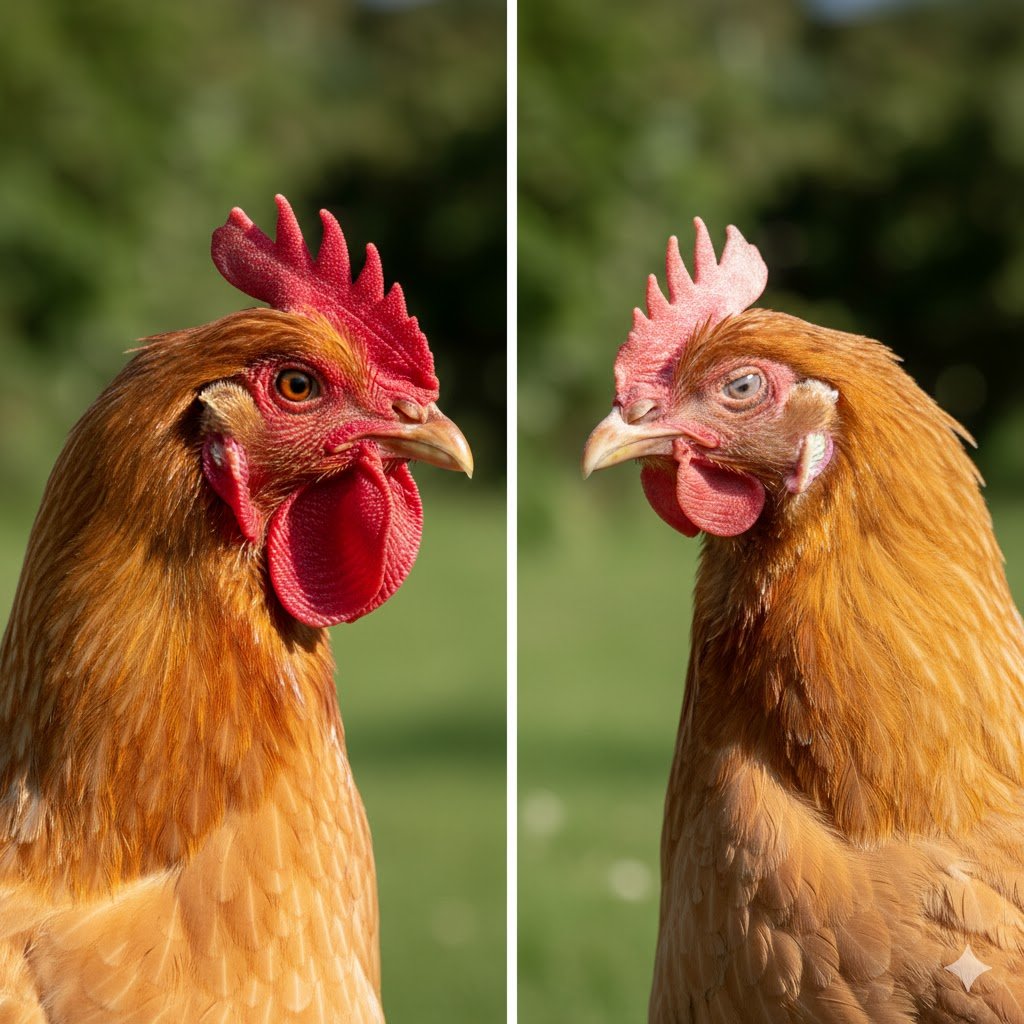
These signs appear as the infestation gets worse. A regular chicken health check can help you spot them early.
- Pale Comb and Wattles: This is the classic sign of anaemia (a low red blood cell count). The mites are literally draining your chicken of blood. A healthy hen’s comb should be deep red; an anaemic hen’s will look pink or even yellowish-white.
- Drop in Egg Production: A stressed, anaemic hen will stop laying.
- Weight Loss & Lethargy: In serious cases, the birds will become weak, sleepy, and lose weight.
- Blood Spots on Eggs: You might find tiny blood smears on your eggs. This is from mites being crushed on the egg after feeding.
These symptoms are your flock’s cry for help. Now that you know what to look for on the bird, it’s time to find the pests themselves.
How to Check Your Coop for Red Mites
You’ve seen the symptoms, so now it’s time to play detective. The best time to check is during the day, when the mites are hiding in their lairs.
You’ll need a torch and a white piece of kitchen roll.
- The Torch Test: Go into your coop and shine a strong torch into every crack and joint. Pay special attention to the perch-ends, especially where they sit in their supports. Look in the joints of the nest boxes and under any roofing felt. You are looking for what appears to be a greyish “ash” or “peppery dust”—this is a cluster of mites, eggs, and faeces.
- The White Paper Test: This is the definitive test. Take your piece of white kitchen roll and wipe it hard along the underside of the perches, especially near the ends. Unfold the paper. If you see tiny grey or red specks (the mites) and, crucially, red-brown blood smears when you squash them, you have a red mite infestation.
- The Sticky Tape Test: For ongoing monitoring, wrap a piece of double-sided sticky tape around the perch-ends before your hens roost. In the morning, check the tape. It will have trapped mites as they travelled to and from your hens.
Where Do Red Mites Typically Live?
Red mites typically live in the cracks and crevices of your wooden coop, especially around perch-ends, nest box joints, and under roofing felt. In UK wooden coops, they thrive in these dark, humid spots due to our mild climate. This is why the torch test is essential—shining light reveals their ‘peppery dust’ clusters (per Poultry Keeper 2025).
Finding these culprits is the final confirmation. But before you start treatment, you need to be 100% sure you’re fighting the right enemy.
Red Mites vs. Northern Fowl Mites: How to Tell the Difference
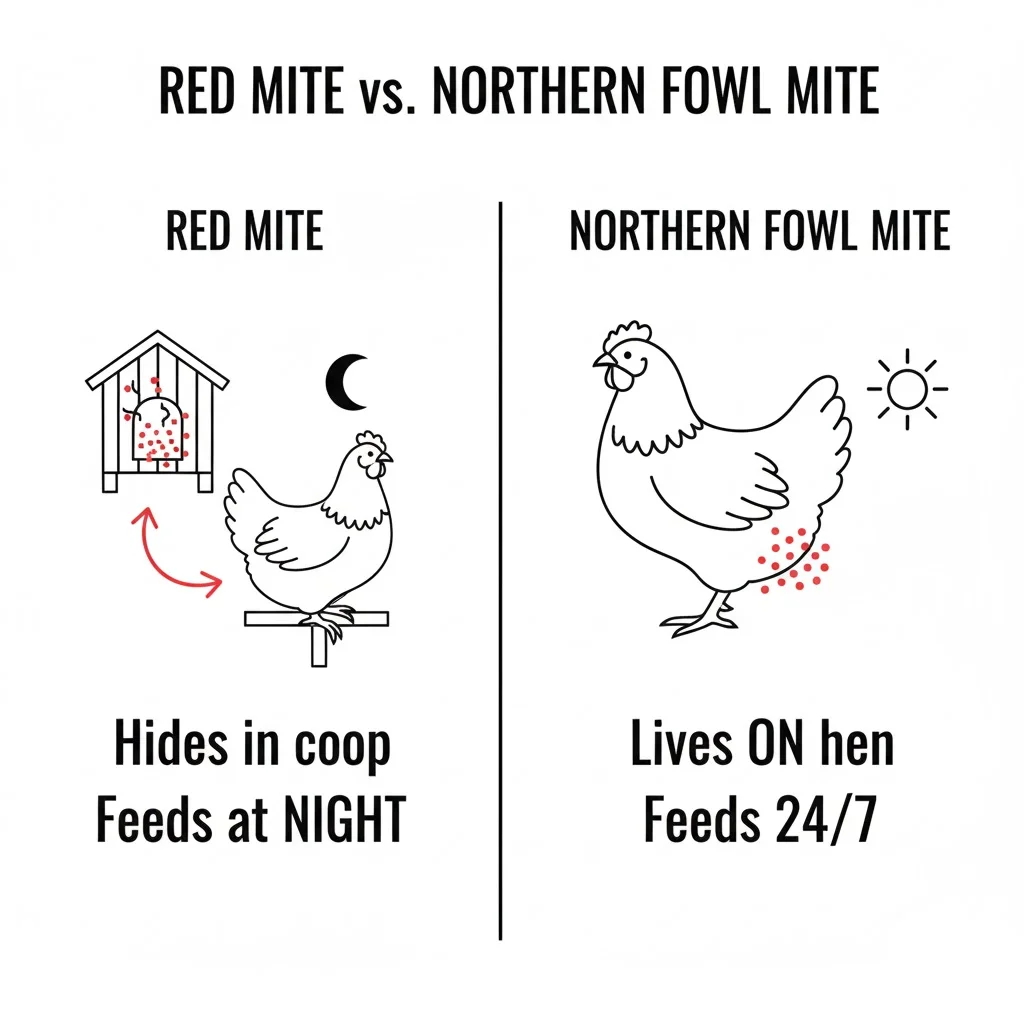
This is a critical distinction, as treating for the wrong mite will fail completely. Many UK backyard keepers confuse the two, waste money on the wrong products, and watch the infestation get worse. (For a general guide on mites and lice on chickens, see our other guide).
The Red Mite (Dermanyssus gallinae)
- Habitat: Lives OFF the bird. It’s a vampire that lives in the coop’s structure (cracks, crevices, perch-ends).
- Activity: Nocturnal. It crawls onto the sleeping hen at night, feeds on its blood, and returns to its hiding place before sunrise to digest and breed.
- Diagnosis: You find them in the coop during the day (using the tests above). You will find very few, if any, on the bird during the day.
- Treatment Focus: The environment. A deep clean and treatment of the coop is the primary goal.
The Northern Fowl Mite (Ornithonyssus sylvarium)
- Habitat: Lives its ENTIRE LIFE on the bird.
- Activity: 24/7. It feeds, breeds, and lays its eggs on the chicken.
- Diagnosis: You find them on the bird during the day. Part the feathers around the vent (cloaca). You will see mites crawling on the skin and clusters of eggs and black, sooty-looking mite faeces matted in the feathers.
- Treatment Focus: The bird. You must treat the hen directly with an approved powder or a vet-prescribed treatment (like Exzolt, which works for both). A coop clean is still good, but it won’t solve a Northern Fowl Mite problem on its own.
The Golden Rule: If you check your bird in the daytime and find mites and “sooty” feathers around the vent, you have Northern Fowl Mites. If your bird is clean but the coop is full of mites, you have Red Mites.
This guide focuses on Red Mites, the most common pest in UK wooden coops. Now that you’re sure you have them, let’s build the battle plan.
How Do You Get Rid of Red Mites in a Chicken Coop?
Getting mites out of a coop, especially a wooden one, isn’t a single job—it’s a deep clean and a multi-step treatment. You have to be thorough and relentless.
First, Get Your Battle Kit Ready
Before you start, get your kit ready. There’s nothing worse than getting halfway through and realising you’re missing something. You can find most of these at UK farm suppliers or large online retailers.
- Gloves (disposable or heavy-duty)
- A face mask (especially for using powders)
- Old clothes or overalls
- A temporary pen for your hens
- A scraper (an old wallpaper scraper is perfect)
- A bucket, hot water, and a stiff brush
- A poultry-safe detergent cleaner (like Poultry Shield)
- A pressure washer (optional, but very helpful)
- A residual insecticide spray (like Nettex Total Mite Kill)
- Diatomaceous Earth (DE) and a puffer bottle
- Pet-safe silicone sealant (for later)
The 8-Step Coop ‘Deep Clean’ Method
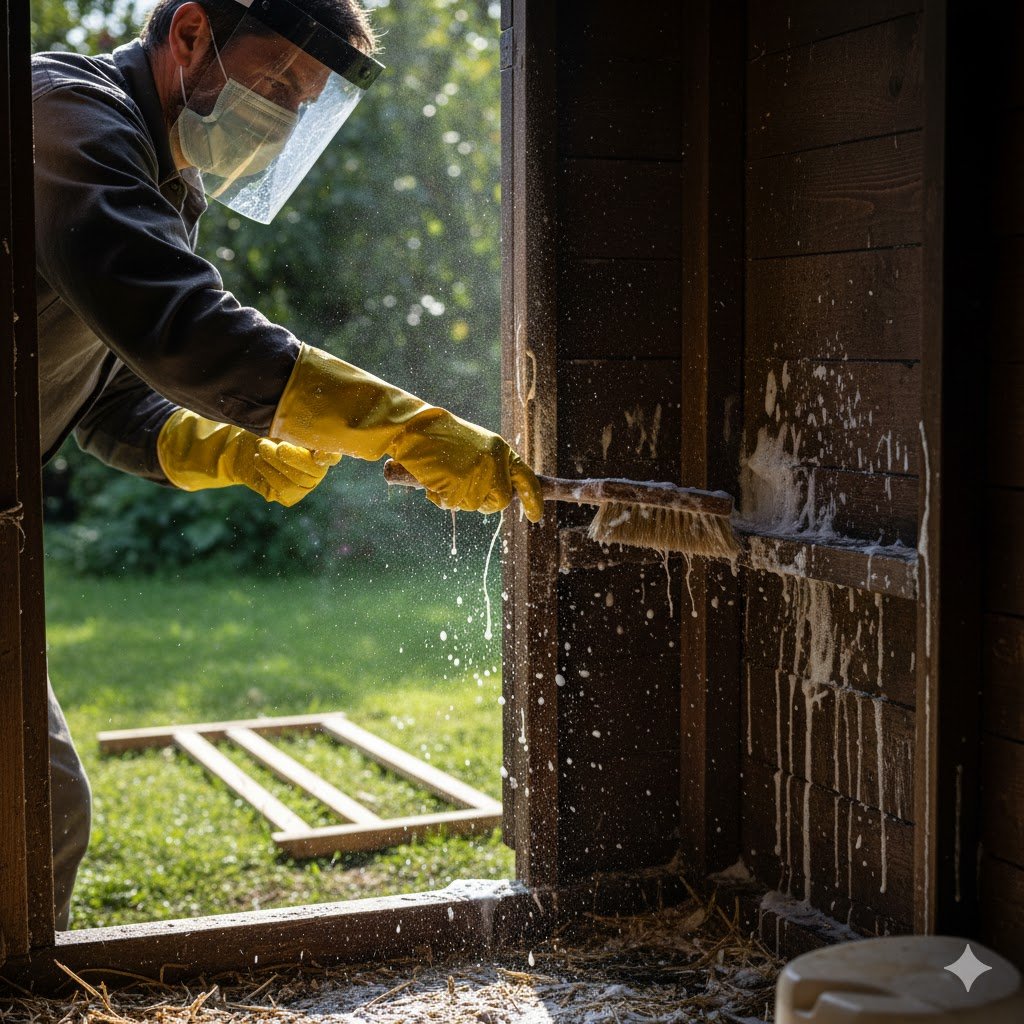
Here is the step-by-step method I use, which is backed by UK poultry experts like the BHWT (2025 guides). Plan to do this on a dry, sunny day if possible.
- Move Your Hens: First, move your flock to a safe, temporary run. This process will take a few hours, and you don’t want them breathing in dust or cleaning products.
- Strip the Coop: Remove everything. All bedding, all dust, all removable perches, and all nest boxes. Scrape off any dried-on droppings.
- Bag and Bin: Put all old bedding and scrapings into a sealed bag (like a rubble sack or thick bin bag) and get it off your property. Do not compost it—you will just be breeding a new mite colony.
- Scrub and Soak: Get a bucket of hot water and add a poultry-safe detergent like Poultry Shield. This product is brilliant because it’s designed to break down the waxy shell of the mites. Scrub every single surface, paying special attention to corners, joints, and perch-ends.
- Blast the Cracks: If you have one, use a pressure washer (on a low setting, so you don’t damage the wood) to blast water into every joint and crack. This physically flushes out thousands of mites and their eggs that your brush missed.
- Let It Dry (Properly): This is a critical step in the damp UK. The coop must be bone dry before the next step. On a sunny day, this is easy. In our soggy winters, you might need to leave it for a full day or use fans. Mites love damp, dark places.
- Apply a Treatment Spray: Once dry, spray the entire coop with a specific red mite spray. Products like Nettex Total Mite Kill Spray are designed for this. They contain permethrin, which kills mites on contact and has a residual effect. Get the nozzle right into the joints and cracks and soak them.
- Apply a Drying Powder: After the spray has dried, puff a drying powder like Diatomaceous Earth (DE) into all the same cracks, perches, and nest boxes. This acts as a physical killer, drying out any mites that crawl over it.
This deep clean is a huge step, but the type of coop you have—wood—presents its own special challenges that need to be addressed.
How to Treat Wood for Red Mites?
Wooden coops are the biggest challenge. Plastic coops are easier to clean, but many of us (myself included) prefer the look and feel of wood. The key is to make the wood as unwelcoming as possible.
Why Wooden Coops are a Mite ‘Holiday Home’
Mites don’t care about the wood itself; they care about the gaps.
- Cracks & Crevices: Tongue-and-groove panels, joints, and any gaps are perfect, dark hiding spots.
- Felt Roofs: This is a major culprit. Mites love to live in the layers of roofing felt and under the eaves. If you have an old felt roof, consider replacing it with Onduline or another solid material.
- Porous Surface: Wood absorbs moisture, which can create the humid environment mites love.
A Deeper Dive: Sealing Your Coop for Good
This is my top tip for wooden coops. Once your coop is clean (from the deep clean) and 100% dry, get a tube of pet-safe silicone sealer (like you’d use for an aquarium). A tube costs around £5-£10 and is a brilliant investment.
- Where to apply: Run a bead of sealer along all the internal joints and cracks.
- Pay special attention to the corners.
- Seal the gap between the floor and the walls.
- Seal around the perch supports. This permanently removes their favourite hiding places.
Alternative Wood Treatments (And What to Avoid)
- Lime Washing: This is an old-school method that still works. A “slaked lime” wash (from a builder’s merchant) is highly alkaline and makes the wood surface very hostile to mites. It needs to be reapplied yearly but is a great non-chemical option.
- Paint: A thick coat of pet-safe paint (like a gloss) can seal small cracks, making the surface easier to wipe clean, similar to plastic.
- The Creosote Warning: You may see old-school advice recommending creosote. Do not use it. Traditional creosote is banned in the UK for amateur use as it’s harmful to health and the environment, according to DEFRA regulations. Modern “creosote substitutes” are not the same and are not proven effective against mites.
Cleaning and sealing the wood is a physical war. Now you need the chemical and biological weapons to finish the job.
What Is the Best Red Mite Killer?
This question needs to be split in two: the best killer for your hens and the best killer for your coop. This section also covers “Best red mite treatment UK” and “Chicken mite treatment UK”.
Best Treatment for the Hens (The ‘Gold Standard’)
The best, most effective, and safest red mite killer on the UK market today is Exzolt.
- What it is: A prescription-only medicine you get from your vet, containing the active ingredient Fluralaner.
- How it works: It’s a treatment you add to your chickens’ drinking water. The hens drink it, and it enters their bloodstream. When a mite bites the hen, it ingests the medicine and dies.
- Why it’s the best: It kills 99% of the mite population in days (per MSD Animal Health 2025 data). It breaks the entire breeding cycle by killing mites that feed, which stops them from laying more eggs.
- Withdrawal Periods: This is the key part. It has a zero-day egg withdrawal period, so you can safely continue to eat the eggs. However, it does have a 14-day meat withdrawal period, so it’s essential to factor this in if you keep birds for meat.
How to Get a Prescription for Exzolt in the UK
Since it’s prescription-only, you can’t buy it off the shelf.
- Call Your Vet: Find a vet that treats poultry (not all do!). Many farm vets will.
- Explain the Situation: Tell them you have a confirmed red mite infestation and are requesting Exzolt.
- Consultation: They will likely need to see one of the birds or at least have a consultation with you. They are legally required to ensure the medicine is prescribed responsibly under Veterinary Medicines Directorate (VMD) rules.
- Cost: Be prepared. The medicine itself can cost around £50-£60 for a small flock, plus the vet’s consultation fee. In my opinion, it’s worth every penny to solve the problem fast.
Best Treatment for the Coop (Surface Killers)
For the coop itself, the best killer is a permethrin-based residual spray. These are your main “Red Mite spray for chicken coops.”
- What it is: Products like Nettex Total Mite Kill Spray or Smite Professional, available from UK farm suppliers and online, typically costing £12-£15.
- How it works: These sprays kill mites on contact and leave a residue that kills any mites that walk over it for days or weeks.
- Pros: Very fast knockdown. Kills mites that aren’t even feeding.
- Cons: Check the label! Most permethrin-based sprays do have an egg withdrawal period (usually 7 days). You must discard all eggs laid during this time.
- How to Apply Safely:
- Remove hens, feed, and water.
- Wear gloves and a mask.
- Saturate all surfaces, especially cracks.
- Let the coop dry completely before the hens return.
- Obey the egg withdrawal period on the label.
Table: Top UK Red Mite Treatments (2025)
| Treatment | Type | Target | Egg Withdrawal | UK Legal Status | Approx. Cost (2025) | Pros | Cons |
|---|---|---|---|---|---|---|---|
| Exzolt | In-water (Vet) | Hens (Internal) | Zero days (Meat: 14 days) | Prescription-Only (VMD) | £50-£60 for small flock | 99% efficacy; no egg withdrawal | Vet visit required; higher upfront cost |
| Nettex Total Mite Kill | Spray (Permethrin) | Coop (Surface) | 7 days (check label) | General Sale | £12-£15 (500ml) | Instant kill; residual effect | Chemical; has egg withdrawal period |
| Poultry Shield | Detergent | Coop (Cleaner) | No | General Sale | £10 (1L) | Eco-friendly; safe to use; kills eggs | Not a standalone killer; no residual effect |
| Diatomaceous Earth (DE) | Powder (Physical) | Coop (Cracks) | No | General Sale | £10/kg | Natural; long-lasting; safe | Dusty—wear mask; less effective if damp |
| Androlis Mites | Predator Mite | Coop (Biological) | No | General Sale | £20-£30/tube | Eco-control; no chemicals | Less effective in heavy infestations; needs re-application |
Using these products will clear an infestation, but an empty coop is a blank slate. You need to set up your defences to stop them from coming back.
What Can I Put in My Chicken Coop to Prevent Mites?
Prevention is always better than a cure. A “proactive defence” strategy is the key to a stress-free chicken-keeping life. Once your coop is clean, you need to keep it that way.
How to Use Diatomaceous Earth (DE) Safely and Effectively
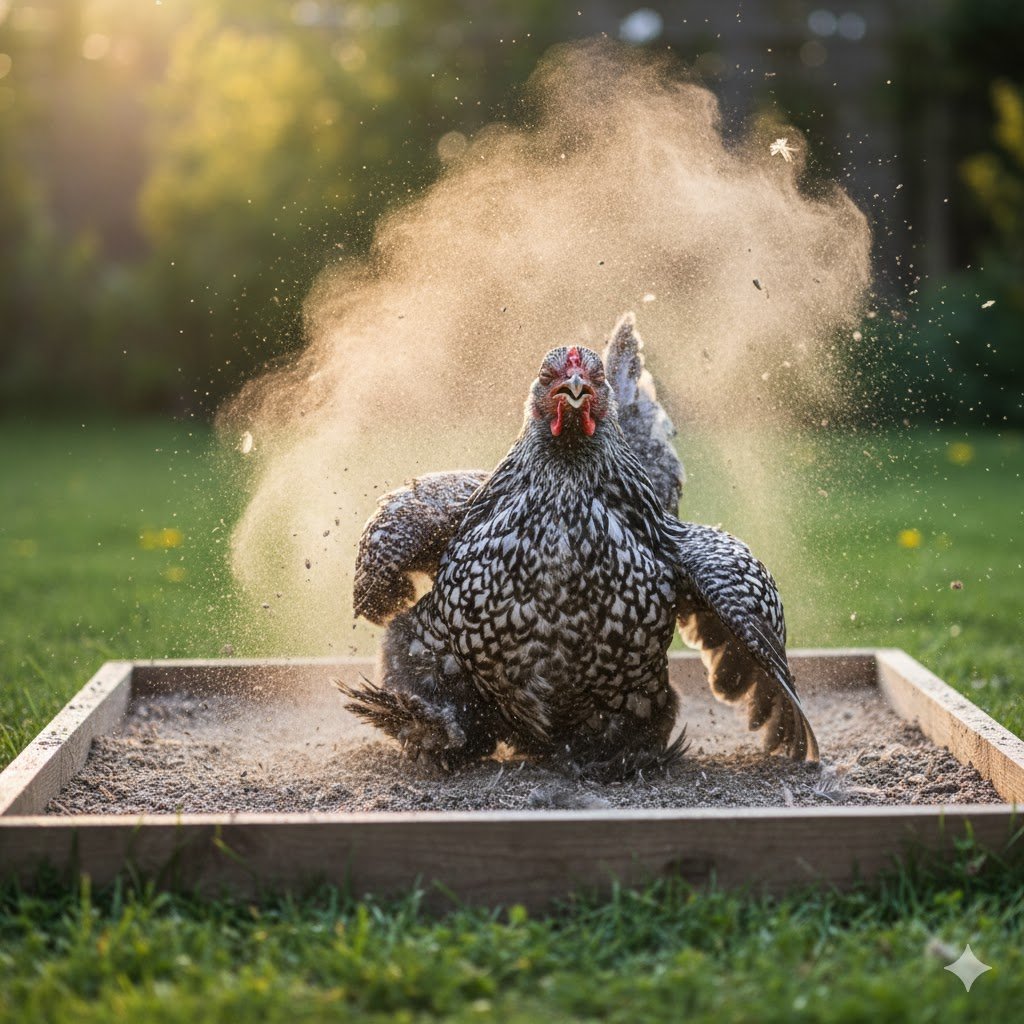
This is the number one red mite prevention product in the UK. (See our full guide on using diatomaceous earth for chickens and mites). DE is a natural powder made from fossilised algae. To a mite, it’s like crawling over broken glass—it scratches their waxy shell, and they dry out and die.
- Get the Right Stuff: Make sure you buy “food grade” DE. A 1kg bag costs around £10-£15 from UK suppliers.
- Safety First: Always wear a mask when applying it. The fine dust is not good for your lungs (or your hens’ lungs). Apply it before you add fresh bedding.
- Application: Use a puffer bottle or a small scoop to puff the powder into all cracks, joints, under perches, and in nesting boxes.
- Bedding Mix: I also mix a scoop or two into the fresh bedding (like straw or wood shavings) as I lay it down.
Using Predator Mites (Androlis): A Complete Guide
This is a brilliant, biological control method. Androlis predator mites are “good bugs” that you buy online (from places like Dragonfli in the UK) and release into your coop.
- How they work: They actively hunt and eat poultry red mites and their eggs.
- When to use: They are best used for prevention or for a very low-level infestation. Release them in spring before mite numbers explode.
- How to use: They come in a tube or bottle. You sprinkle them around the coop, especially near the perches.
- Cost & Warning: This is a more expensive option, often costing £20-£30 for a tube. You cannot use predator mites at the same time as DE or insecticide sprays. The chemicals will kill your “good bugs” too.
Creating the Ultimate Red Mite-Proof Dust Bath
Hens naturally try to control parasites by dust bathing. You can help them by creating a good dust bath area and mixing in the right ingredients. This is a natural mite prevention powerhouse.
- Location: Find a dry, sheltered spot in their run. A large car tyre, a wooden box frame, or a kid’s sandpit all work well.
- The Recipe: Fill it with a mix of:
- 50% Dry, loose soil or sand
- 40% Wood ash (from a bonfire or wood burner – make sure it’s only wood ash)
- 10% Food Grade Diatomaceous Earth
- The hens will love it, and it will keep their feathers in top condition while actively killing any parasites.
UK-Specific Prevention Tips for Damp Weather
In the UK’s rainy conditions, especially in wetter areas like Scotland or the South West, mites can breed faster due to the damp. It’s vital to ensure your coop has good ventilation. Use breathable tarps on runs to keep the area dry without trapping moisture, and make a point to deep clean and check for mites at least quarterly, even in cooler months, to comply with DEFRA’s biosecurity (2025) advice.
These preventative measures work because they attack the mite’s lifecycle. Understanding that cycle is the key to winning the war.
How Long Do Red Mites Live on Chickens?
This is a common mix-up. Red mites do not live on chickens.
They are like tiny vampires. They live in the cracks and crevices of the coop, and at night, they crawl onto the hens to feed on their blood. Before sunrise, they crawl back into their hiding places to digest, mate, and lay eggs. This is why treating just the hen (with a powder) often fails. You miss the 95% of the population hiding in the wood.
The Red Mite Lifecycle: Know Your Enemy
Understanding this is how you beat them.
- Egg: Mites lay eggs in the cracks.
- Larva: Eggs hatch into larvae.
- Nymph: Larvae moult into nymphs.
- Adult: Nymphs become adults, ready to feed and breed.
The entire red mite lifecycle can be completed in just 7 days in warm UK summer weather. This is why you must repeat your treatment after 7 days to kill the new hatchlings.
And here’s the scary part: an adult red mite can survive without a blood meal for up to 9 months. This fact (reaffirmed by poultry bodies in 2025) is why a coop that has been empty all winter can suddenly have a massive infestation when you put new birds in.
This brings up a very common question in the UK: if they can survive so long, what happens to them when it gets cold?
What Happens to Red Mites in Winter in the UK?
Many keepers deep-clean their coop in autumn and think a cold winter will solve their mite problem. Unfortunately, it won’t. (This is a key part of our winterizing chicken coop guide).
Do Red Mites Die in Winter?
No, not all of them. A hard frost or freezing temperatures might kill some of the active adult mites, but it will not kill the eggs or the young mites.
How They Survive: Dormancy (Diapause)
Red mites are incredibly resilient. As the temperatures drop (especially below 5°C-10°C), the remaining population and their eggs go into a dormant state called “diapause.”
- They hide deep in the woodwork.
- Their metabolism slows right down.
- The eggs simply wait, viable, for the temperature to rise again.
This is why the UK “mite season” (May-October) is so explosive. The population wasn’t zero in April; it was just dormant. As soon as the weather warms up, the eggs hatch, the nymphs become active, and the population explodes.
This ability to “pause” their lifecycle makes them a year-round threat, which is why your treatment plan is so important, especially when it comes to the food your hens produce.
Is It Safe to Eat Eggs from Chickens with Mites?
This is a top concern, and the answer is a relief.
Mites, Eggs, and Your Health: The Facts
Yes, it is generally safe to eat the eggs. The mites are interested in the chicken’s blood, not the eggs. They don’t infect the egg itself. A severe poultry red mites infestation UK can cause hens to become so anaemic and stressed that they stop laying, but the eggs they do lay are fine to eat (though you should check rules on how to legally sell your backyard chicken eggs if you plan to).
What if I see a mite on an egg? This can happen if you collect eggs first thing in the morning. It’s gross, but just wash the mite off. The egg inside is perfectly fine.
A Critical Guide to UK Egg Withdrawal Periods
The real danger to your eggs comes from the treatments.
- Egg Withdrawal: This is the time you must discard eggs after using a medicine or chemical, as traces could be in the eggs.
- Exzolt: Zero-day withdrawal. This is its biggest selling point, as confirmed by the BHWT 2025 guidance. (Remember the 14-day meat withdrawal).
- Permethrin Sprays (e.g., Nettex): Varies by brand. Often 7 days, but you MUST read the label. It will clearly state the withdrawal period.
- DE / Predator Mites / Poultry Shield: Zero-day withdrawal. These are physical or detergent-based, not chemical, so they are safe.
Knowing your eggs are safe is a relief, but if you have a severe infestation, your priority is speed. You need a plan to get your hens safe now.
What Kills Red Mites Instantly?
This is a very common question, and the answer is a “yes, but…”.
So, what’s the magic bullet?
“Instantly” refers to contact killers. These are products or methods that kill mites immediately when they touch them.
- Permethrin Sprays: Products like Nettex Total Mite Kill are insecticides that kill on contact. This is the fastest chemical way to kill visible mites.
- Hot Water/Steam: A steam cleaner or a kettle of boiling water poured into the cracks of a disassembled coop will kill mites and their eggs instantly. This is a non-chemical instant killer, but it’s very labour-intensive and you must let the wood dry completely.
- Detergent Sprays: Poultry Shield and other cleaners will kill mites on contact by dissolving their waxy shells, but they have no residual effect.
The Important Caveat: “Instantly” does not mean the infestation is gone. Killing the mites you can see is only 5-10% of the battle. The thousands of eggs and mites hiding deep in the wood will be untouched.
An instant killer is just one tool in your “Red Alert” plan. It is not the whole solution and must be combined with a treatment like Exzolt to target the full lifecycle.
What Is the Fastest Way to Get Rid of Mites on Chickens?
A true “fast” solution means eradicating the entire population, not just the visible ones. This requires a combined-arms attack. This is the “Red Alert” plan.
The ‘Red Alert’ Plan for a Heavy Infestation
- Today (Day 1): Call your vet and get a prescription for Exzolt. Administer the first dose in their water. While they are drinking it, move them to a temporary pen.
- Today (Day 1): Perform the full 8-Step Deep Clean. Scrub with Poultry Shield, dry the coop, and apply a red mite spray (your “instant killer”) like Nettex Total Mite Kill.
- Day 2: Once the spray is dry, puff DE powder into all the cracks and add fresh bedding mixed with DE. Put the hens back in.
- Day 7: Administer the second dose of Exzolt as prescribed.
- Day 8: Do a follow-up spray and DE treatment in the coop to kill any new hatchlings.
This two-pronged attack, as recommended by vets like St David’s Poultry Team (July 2025), is the fastest and most effective way to get a total kill.
How to Care for an Anaemic Hen
If an infestation is bad, your hens may be anaemic (lacking red blood cells).
- Signs: Pale comb and wattles, lethargy, and weakness.
- Action: Contact your vet. They may suggest an iron supplement (like a poultry tonic, available for around £10-£15) to add to their water alongside the mite treatment. Give them high-protein treats like a few mealworms to help them recover their strength.
During this “Red Alert” clean-out, you’ll be covered in dust and grime. This leads to another common, and slightly creepy, question.
Are Red Mites Harmful to Humans?
This is a very common worry, and the answer is thankfully straightforward.
Here’s the good news: No, humans cannot get red mites. They cannot live on you, breed on you, or infest your home. This is confirmed by public health and poultry sources like Poultry Keeper (2025). While not harmful long-term, red mite bites on humans cause itchy red bumps and irritation, similar to mosquito bites. They’re not dangerous but can be very uncomfortable during cleaning (BHWT 2025).
However, if you are handling an infested hen or cleaning a heavily infested coop, the mites will crawl on you and they will bite.
Identifying Red Mite Bites on Humans
I’ve had it happen, and let me tell you, it’s horrible. It’s not dangerous, but the feeling of them crawling on you and the intense itch from the bites kept me up at night.
- What they look like: Tiny, itchy red bumps, often clustered together. They look like little pinpricks.
- Where: Usually around your wrists and arms (where your gloves end) and around your waistband.
- The mites are Dermanyssus gallinae; they are bird mites, not human parasites. A hot shower and a change of clothes will get rid of them.
How to Protect Yourself During a Coop Clean-Out
- Wear wellies and tuck your trousers into them.
- Wear long sleeves and tuck them into your gloves.
- Wear a hat.
- As soon as you are finished, remove your “coop clothes” outside or in a garage, bag them, and go straight for a hot shower.
The experience of being bitten makes you wonder: how did these horrible things get into my clean garden in the first place?
How Did My Chickens Get Red Mites?
This is a question I asked myself. “I’m clean! Why do I have mites in my chicken coop?” It’s usually not your fault. Mites are expert hitchhikers, and this is a key part of DEFRA’s biosecurity advice.
The Main Culprits: A ‘Most Wanted’ List
- Wild Birds (The #1 Culprit): Starlings, sparrows, and pigeons all carry red mites. They can land on or near your coop, and the mites simply crawl off and find your hens.
- New Hens (The ‘Trojan Horse’): You buy a few new birds, and they come with unwanted guests. This is why biosecurity is so important. Always quarantine new birds for 14-21 days in a separate coop to check for mites.
- Second-Hand Equipment: That “bargain” wooden coop you bought online? It likely came with a free, established mite colony. (It’s often safer to invest in one of the best fox-proof chicken coops from a reputable source).
- You: You can even bring them in on your clothes or boots after visiting a friend’s flock or a poultry show.
The Wild Bird Problem in UK Gardens
You can’t stop wild birds, but you can deter them from your coop.
- Cover your chicken run with fine-mesh netting.
- Don’t leave chicken feed scattered on the ground where it will attract them.
- Use treadle-feeders that only the hens can open.
Since wild birds are a key source, it’s good to know that mites also have a place in the natural food chain.
What Eats Chicken Mites?
Believe it or not, chicken mites have a natural enemy: predator mites.
As mentioned in the prevention section, you can buy tubes of predator mites (the most common brand in the UK is Androlis) and release them in your coop. These “good” mites will hunt down and eat the “bad” red mites, their eggs, and their young.
Some spiders and other insects in the coop may also eat them, but not in high enough numbers to act as a reliable control method. For a biological solution, Androlis predator mites are your best bet.
This brings us back to the core of the problem: the coop itself. If wood is so bad, is the alternative any better?
Do Red Mites Live on Plastic?
Yes, they can, but it’s much harder for them. This is why many UK keepers are moving to plastic coops, (like the Omlet Eglu Cube), especially after battling a wooden coop infestation.
The Great Debate: Plastic vs. Wooden Coops
- Wooden Coops:
- Pros: Better aesthetics, good insulation, often cheaper.
- Cons: A “mite magnet” with thousands of hiding spots. Hard to clean. Can rot.
- Plastic Coops:
- Pros: Far fewer hiding spots. Incredibly easy to clean (you can just pressure wash them).
- Cons: More expensive, can have worse ventilation (leading to damp), and can get very hot in summer.
A plastic coop won’t prevent mites, but it makes getting rid of them a 20-minute job with a hose, not an all-day deep clean.
Regardless of your coop type, you’ll need the right treatments, which means understanding the products available.
Exzolt Red Mite Treatment UK: A Deeper Look
We’ve mentioned it as the “gold standard,” so let’s look closer at this specific red mite treatment in water.
Availability and Prescription Guide
As a prescription-only medicine (POM-VPS), Exzolt red mite treatment UK is not available on the shelf. However, it can be prescribed by a vet or a suitably qualified person (SQP), often found at farm supply stores. You can then purchase it from your vet, the supplier, or online pharmacies (like VetUK), provided you have a valid prescription, all compliant with VMD 2025 regulations.
The Exzolt Dosing Process: A Step-by-Step
Your vet will give you exact instructions, but here’s the general process:
- Calculation: Your vet will calculate the dose based on the total weight of your flock.
- Withdraw Water: The night before treatment, remove their drinker. This ensures they are thirsty in the morning.
- Mix the Dose: Mix the prescribed amount of Exzolt into a smaller amount of water than they would normally drink in a day. This is to ensure they drink all of the medicated water.
- Administer: Put the medicated drinker in the coop. Make sure it’s the only water source available.
- Repeat: You must repeat this process exactly 7 days later to kill the next cycle of mites.
Are There Any Other Water-Based Treatments?
You will see many supplements (e.g., garlic, herbs) sold as “red mite treatments” for water. Be very clear: these are not killers. They are nutritional supplements that claim to make the chicken’s blood less tasty to mites. They are not a replacement for Exzolt in an active infestation.
These unproven “natural” remedies are everywhere, and it’s vital to know which ones are myths.
Does Vinegar Kill Red Mites?
No, not reliably. This is a very common myth, and a dangerous one if it’s the only thing you rely on.
The Vinegar Myth: What It Can and Can’t Do
- What it CAN do: White vinegar is a great, non-toxic cleaner. Its acidic nature is brilliant for cleaning droppings off perches and for descaling water drinkers. (For its proper use, see our guide on how to use apple cider vinegar for chickens).
- What it CAN’T do: It is not an insecticide. Despite what some forums say, Poultry Keeper’s 2025 analysis and BHWT tests confirm it is not an effective insecticide. It will not kill mites reliably, and it has zero effect on eggs. It’s fine for a weekly wipe-down but useless for an infestation.
Other ‘DIY’ Mite Remedies (and if they work)
- Garlic: Same as vinegar. May make hens less tasty, but won’t kill an infestation.
- Essential Oils (e.g., Peppermint): Mites don’t like the smell, so it may act as a mild deterrent. It is not a killer.
- Diesel/Creosote: ABSOLUTELY NOT. These are toxic, illegal for this use, will poison your hens, and contaminate their eggs. Never, ever use them. Stick to legal, VMD-approved products.
Don’t rely on myths. Your final line of defence is a proper, approved treatment plan.
A Quick Tip for Better SEO and AI Visibility (FAQ Schema)
Here’s a tip for when you publish this guide. To help search engines like Google and AI models understand your content, you can add “schema markup” to your page’s HTML.
For an article like this, FAQPage schema is perfect. You simply take the questions from your FAQ section (like “What is the best red mite treatment UK?”) and wrap them, along with their answers, in this special code.
It’s a bit technical, but it signals to Google that you are directly answering user questions, which can help you get a better ranking and appear in AI-generated summaries.
Conclusion: Your Plan for a Mite-Free Coop
Getting rid of red mites in a wooden coop in UK is a battle, but it’s not an impossible one. It’s frustrating, I know, but you can win. Don’t feel bad that you have them; every keeper in a wooden coop will face them eventually.
So, what’s the plan?
Your plan is a 3-step attack:
- Identify: Check your hens for symptoms (paleness, restlessness) and your coop for mites (blood smears on a white cloth).
- Deep Clean & Treat Coop: Do the 8-Step Deep Clean. Scrub with Poultry Shield, dry, and apply a residual spray (like Nettex) and DE powder.
- Treat the Hens: Contact your vet for Exzolt. This is the single best way to break the mite lifecycle safely and without throwing away your eggs.
From there, it’s all about prevention. Keep a clean coop, add DE to their dust baths, and seal those wooden cracks.
Go and check the ends of your perches tonight—that’s the first place you’ll spot them. Your hens will thank you for sorting it out.
Frequently Asked Questions (FAQ)
Q1: What is the best red mite treatment UK?
A: The most effective treatment is a two-part approach. First, Exzolt, a prescription-only medicine from your vet that you add to the water. It kills mites that bite the hens and has no egg withdrawal. Second, Nettex Total Mite Kill Spray for the coop itself, which kills mites on contact in the woodwork.
Q2: Is it safe to eat eggs from chickens with mites?
A: Yes, the mites themselves don’t affect the eggs. However, you must check the label of any chemical treatment you use. Many coop sprays (like permethrin) require you to discard eggs for 7 days. Vet treatments like Exzolt have a zero-day egg withdrawal.
Q3: What kills red mites instantly?
A: A permethrin-based contact spray (like Nettex Total Mite Kill or Smite) will kill red mites instantly when you spray it directly on them. However, this won’t kill the eggs or the mites hiding deep in the wood, which is why a residual treatment and treating the hens is also essential.
Q4: How do I treat my wooden coop for red mites?
A: You must do a deep clean. Remove all birds and bedding. Scrub all surfaces with a poultry-safe detergent (like Poultry Shield). Let it dry completely. Then, spray all surfaces, especially cracks and perch ends, with a residual mite spray. Finally, puff Diatomaceous Earth (DE) into all the dry cracks. Repeat the spray/DE treatment 7-10 days later.
Q5: Are red mites harmful to humans?
A: No, humans cannot get an infestation. Red mites are bird parasites and cannot live or breed on humans. However, if you’re cleaning an infested coop, they will crawl on you and bite, which causes small, itchy red bumps. A hot shower will get rid of them.
Q6: What’s the difference between Red Mites and Northern Fowl Mites?
A: Red Mites live in the coop and feed on hens at night. Northern FRowl Mites live on the hen 24/7. You must check the bird’s vent area; if you see mites and sooty feathers, it’s Northern Fowl Mite, which requires a different treatment focus.

Oladepo Babatunde is the founder of ChickenStarter.com. He is a backyard chicken keeper and educator who specializes in helping beginners raise healthy flocks, particularly in warm climates. His expertise comes from years of hands-on experience building coops, treating common chicken ailments, and solving flock management issues. His own happy hens are a testament to his methods, laying 25-30 eggs weekly.
